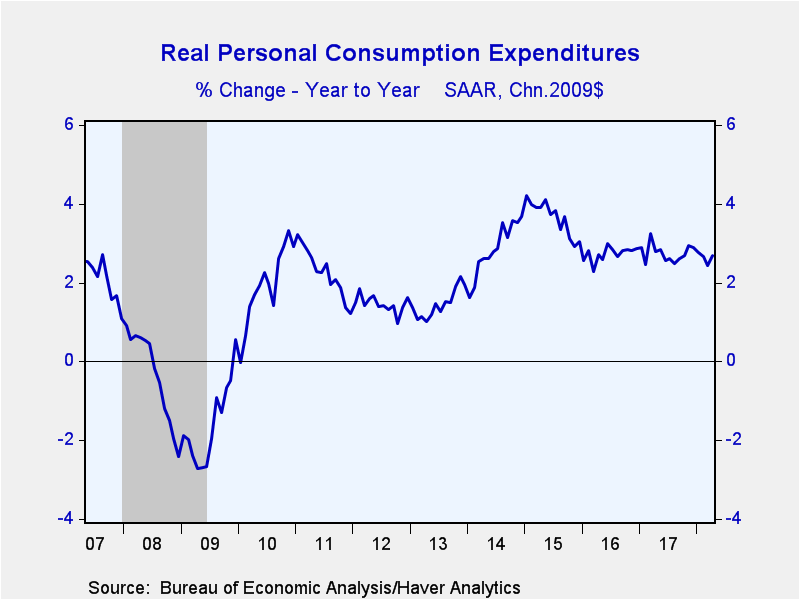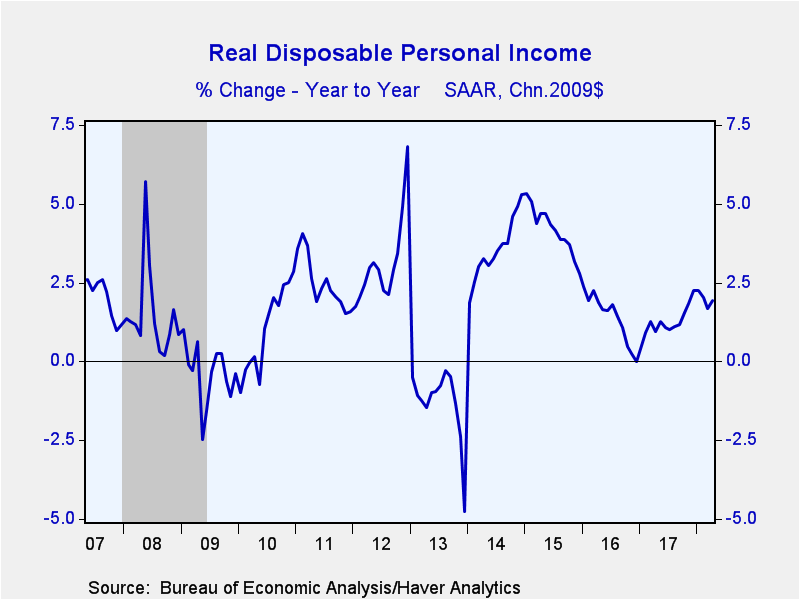 Global| May 31 2018
Global| May 31 2018U.S. Personal Spending Strengthens While Savings Are Reduced
by:Tom Moeller
|in:Economy in Brief
Summary
Personal consumption expenditures increased 0.6% during April (4.7% y/y) following a 0.5% March rise, revised from 0.4%. It was the strongest monthly increase since November. A 0.4% rise had been expected in the Action Economics [...]
Personal consumption expenditures increased 0.6% during April (4.7% y/y) following a 0.5% March rise, revised from 0.4%. It was the strongest monthly increase since November. A 0.4% rise had been expected in the Action Economics Forecast Survey.
Real personal spending rose 0.4% (2.7% y/y) after a 0.5% gain. In constant dollars, durable goods spending improved 0.3% (6.8% y/y) after a 1.9% jump. A 0.5% gain in purchases of motor vehicles & parts followed a 4.6% surge, but outlays on home furnishings & appliances declined 0.7% (+6.6% y/y) and retraced half of the March strengthening. Purchases of recreational goods & vehicles fell 0.2% (+3.4% y/y), down for the second straight month. Outlays on nondurable goods rose 0.4% (2.8% y/y) for the second consecutive month. Clothing & footwear purchases gained 0.5% (1.6% y/y) after a 1.0% jump while gasoline & oil buying surged 1.7% (1.5% y/y) as it did in March. Spending on food & beverages eased 0.2% (+2.9% y/y) following a 0.4% gain. Services spending rose 0.4% (2.0% y/y) after a 0.3% rise. Housing & utilities outlays surged 0.9% (2.0% y/y) for a second straight month while spending on recreation services jumped 1.3% (2.2% y/y) after a 0.2% gain. Health care outlays gained 0.1% (1.9% y/y) after two straight months of moderate decline while outlays at restaurants & hotels fell 0.3% (+1.5% y/y).
Personal income rose an expected 0.3% (3.8% y/y) following a 0.2% rise. Wages & salaries improved 0.4% (4.6% y/y) after a 0.2% rise. Proprietors income inched 0.1% higher (3.8% y/y) after a 0.3% rise and rental incomes improved 0.3% (4.2% y/y) following a 0.6% gain. Personal interest income gained 0.4% (2.9% y/y) after declining for three straight months while dividend payments held steady (+4.0% y/y) after rising 0.8%. Transfer receipts increased 0.3% (3.1% y/y) following a 0.4% gain. Social security payments inched 0.1% higher (4.9% y/y) after a 1.0% strengthening. Medicare payments rose 0.5% (3.1% y/y), the strongest monthly increase in three years and Medicaid payments ticked 0.1% higher (4.0% y/y) following a 0.3% rise. Unemployment insurance payments declined 1.9% (-8.7% y/y). Veterans benefits strengthened 3.7% and doubled the y/y increase to 10.9%.
Disposable income increased 0.4% (3.9% y/y after a 0.2% rise. Real disposable income increased 0.2% (1.9% y/y) for a second straight month.
The strength in spending, accompanied by lesser income growth, reduced the personal savings rate to 2.8%. It was the lowest level since December, and half of what it was as recently as 2016. Personal savings declined 20.0% y/y.
The chain type price index increased 0.2% (2.0% y/y) following stability in March. The index excluding food & energy rose 0.2% (1.8% y/y) for the third straight month. Energy prices surged 1.5% (8.4% y/y) after a 2.8% decline and food prices rose 0.3% (0.5% y/y) following a 0.2% gain.
The personal income & consumption figures are available in Haver's USECON database with detail in the USNA database. The Action Economics figure is in the AS1REPNA database.
| Personal Income & Outlays (%) | Apr | Mar | Feb | Apr Y/Y | 2017 | 2016 | 2015 |
|---|---|---|---|---|---|---|---|
| Personal Income | 0.3 | 0.2 | 0.3 | 3.8 | 3.1 | 2.4 | 5.0 |
| Wages & Salaries | 0.4 | 0.2 | 0.4 | 4.6 | 3.3 | 2.9 | 5.1 |
| Disposable Personal Income | 0.4 | 0.2 | 0.3 | 3.9 | 2.9 | 2.6 | 4.5 |
| Personal Consumption Expenditures | 0.6 | 0.5 | 0.0 | 4.7 | 4.5 | 4.0 | 3.9 |
| Personal Saving Rate | 2.8 | 3.0 | 3.3 | 3.7 (Apr.'17) |
3.4 | 4.9 | 6.1 |
| PCE Chain Price Index | 0.2 | 0.0 | 0.1 | 2.0 | 1.7 | 1.2 | 0.3 |
| Less Food & Energy | 0.2 | 0.2 | 0.2 | 1.8 | 1.5 | 1.8 | 1.3 |
| Real Disposable Income | 0.2 | 0.2 | 0.1 | 1.9 | 1.2 | 1.4 | 4.2 |
| Real Personal Consumption Expenditures | 0.4 | 0.5 | -0.1 | 2.7 | 2.8 | 2.7 | 3.6 |
Tom Moeller
AuthorMore in Author Profile »Prior to joining Haver Analytics in 2000, Mr. Moeller worked as the Economist at Chancellor Capital Management from 1985 to 1999. There, he developed comprehensive economic forecasts and interpreted economic data for equity and fixed income portfolio managers. Also at Chancellor, Mr. Moeller worked as an equity analyst and was responsible for researching and rating companies in the economically sensitive automobile and housing industries for investment in Chancellor’s equity portfolio. Prior to joining Chancellor, Mr. Moeller was an Economist at Citibank from 1979 to 1984. He also analyzed pricing behavior in the metals industry for the Council on Wage and Price Stability in Washington, D.C. In 1999, Mr. Moeller received the award for most accurate forecast from the Forecasters' Club of New York. From 1990 to 1992 he was President of the New York Association for Business Economists. Mr. Moeller earned an M.B.A. in Finance from Fordham University, where he graduated in 1987. He holds a Bachelor of Arts in Economics from George Washington University.










